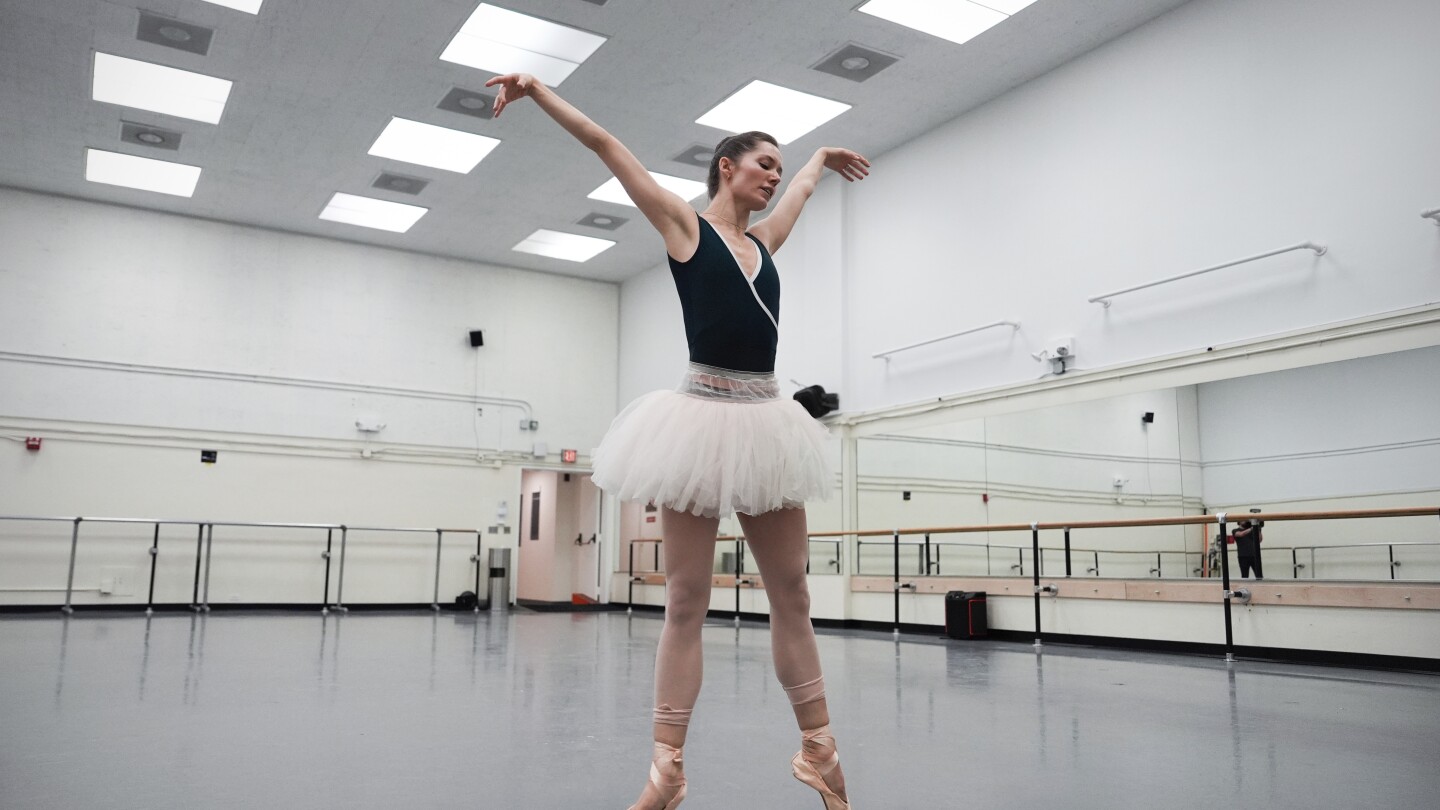Lifestyle
Fluttering arms, aching calves, bursting lungs: ‘Swan Lake’ is a ballerina’s Mount Everest

NEW YORK (AP) — Rehearsing “Swan Lake” a few weeks ago in a sweaty studio, trying to iron out some last-minute kinks, ballerina Unity Phelan stopped just before launching into the famed 32 fouettés — those crowd-pleasing whiplash turns on one leg performed by Odile, the devious Black Swan.
“No fouettés today — save them for tonight,” directed Phelan’s coach at New York City Ballet, Kathleen Tracey. Dancer and coach agreed: preserving Phelan’s precious leg muscles took priority over rehearsing the fiendishly difficult move.
Phelan was a few hours away from performing the dual role of Odette and Odile for the second time, four days after her debut. It’s a goal she’d had since childhood. Achieving it at age 30 was a bucket-list moment like no other — witnessed by friends, family, “all of New Jersey” (her home state) and a few thousand others.
It was also probably the most physically challenging feat of her career.
Many across the world know “Swan Lake,” the most iconic of all ballets. Far fewer know just how hard the main ballerina role is to perform. As graceful and ephemeral as it appears, Odette-Odile is a dancer’s Mount Everest, requiring stellar technique, prodigious training, uncommon stamina, emotional resilience — and even carbo-loading.
The ballerina dances virtually nonstop for 2 ½ hours, with a quick intermission for refueling. The toughest part comes toward the end — when she’s most tired, of course — with trickster Odile unleashing a dazzling display as she misleads the prince in a tragedy of mistaken identity. Even before she gets to the dastardly fouettés — the word means “whipped” in French — the dancer has to huff and puff just to make the entrance.
There’s “hardly enough time to get to the back wing, and then you’re back out,” Phelan explains. “You’re so exhausted and you have to run back out and keep going.” So exhausted that at dress rehearsal, she remarked to another dancer as she raced to her entrance: “Man, I’m questioning all my life choices right now!”
She was kidding, of course. Phelan was one of three lucky NYCB ballerinas tapped to debut the role this past season, a new generation of swan queens discovering the ecstasy and the agony in one of ballet’s toughest gigs.
You can’t give up on yourself
For Mira Nadon, swan queen glory has arrived early, at 23. The fast-rising ballet star became a principal dancer in 2023, the first Asian American female principal in the company. Her wunderkind reputation was only enhanced with her debut as Odette-Odile this season, which had many in the audience marveling at her technique and artistry.
Nadon, like Phelan, says the role was always her dream — not that she thought it would come so soon.
“Of all the full-length ballets,” Nadon said in an interview, “this is the one that I most identify with, and really hoped to get to do one day.”
Even in the rarefied air of being a principal at a top company, it’s not a given that you get to dance a role like this. NYCB ballerina Sara Mearns famously got the part at 19, when she was still in the corps de ballet, and continued to dance it this season, along with fellow longtime star Tiler Peck. But many never get the chance. The last time the company ran its full-length “Swan Lake, choreographed by Peter Martins, was five years ago, just before the outbreak of the coronavirus pandemic. A later run was canceled due to COVID-19 concerns.
Unity Phelan rehearses for her role as Swan Queen (AP Photo/Julia Demaree Nikhinson)
So Nadon was thrilled when she was told in the fall that she’d be donning the swan feathers. During the busy “Nutcracker” run over the holidays, she began working with her coach, Rebecca Krohn, to learn the steps and “have them settle into my body.” It is that muscle memory, dancers say, that often saves them when things are tough. And like any athlete, Nadon spent the season building up stamina so that it would be at peak form for “Swan Lake.”
Even so, the role was a challenge.
“You have to accept that you will be tired, and you just have to push through it and trust yourself,” she says. “Because when you have something that is so taxing, it’s a little bit mental. You can’t give up on yourself. You have to really believe that you can do it.”
Your mind wants you to stop
It was that very self-belief that Miriam Miller says she had to fight for.
“I kind of thought it was off the table, like I wasn’t really going down that route,” says Miller, 28, who became a principal just weeks before her “Swan Lake” debut. She said she never saw herself as a great turner, or able to master some of the Black Swan’s tricky footwork.
“It has every single ballet step in the book,” Miller says of the iconic ballet. “In White Swan, it’s so delicate and we strive to be perfectly placed and thoughtful about all the in-between steps … so that takes a different effort,” she says. “Then you have 25 minutes (for intermission), you have to do a quick change, you have to change your shoes, you have to eat, you have to just kind of reset.”
And that’s just the physical part.
“It takes a lot of mental strength and self-awareness,” Miller adds. “You’re fully depleting yourself in every single way.”
A pin on Unity Phelan’s bag is pictured during a rehearsal (AP Photo/Julia Demaree Nikhinson)
Somehow, she triumphed over her own doubts, and sounded exhilarated the morning after her debut, despite the throbbing muscles.
“It’s hard sometimes to go out onstage and not let your mind take over,” Miller says. “Our bodies are inherently lazy and our mind is also lazy, and so it wants to tell you. ‘Stop, you’re exhausted, just give up.’ If there is something I’m proud about, it’s that I didn’t let those thoughts interfere with the performance.”
Carbo-loading, electrolytes, bananas and protein bars
Miller laughs when hearing the anecdote that actor Natalie Portman, prepping for her “Black Swan” movie role, subsisted on carrots and almonds to get in ballerina shape.
In real life, dancing that role without serious fueling? “She would have been dead on the floor,” Miller said.
To fuel her own body, Miller carbo-loaded like a marathoner and took electrolytes and energy supplements ahead of the performance. During the show itself, she snacked on a peanut butter protein bar and a banana. For Nadon, it was a sandwich beforehand, then electrolytes, yogurt and a banana during intermission.
For Phelan, it was half a banana during the break, plus packing in carbs and protein the day before and remembering to eat well on performance day, a marathon that began with morning class and then rehearsal, attended as always by her cavalier King Charles spaniel, Pippin.
Repertory Director Kathleen Tracey watches Joseph Gordon and Unity Phelan rehearse (AP Photo/Julia Demaree Nikhinson)
Unity Phelan and Joseph Gordon rehearse (AP Photo/Julia Demaree Nikhinson)
“You’re nervous, so you’re not very hungry,” Phelan says. “But you have to make sure you eat because otherwise, you won’t have anything in you to help.”
Whatever they ate, it worked. Now, they’re left with memories like the moment the lights went up during curtain calls and Phelan could finally make out some faces.
“It was completely full, people were standing and I was hit with a wave of, ‘Oh my God, there were 2,500 people watching this! And they liked it.’”
And they’re left with something else, too. Aches, everywhere.
“I’ve definitely never been this exhausted after a show,” quips Miller.
Lifestyle
Allergy season: How to check pollen levels and alleviate symptoms

ATLANTA (AP) — Allergy season can be miserable for tens of millions of Americans when trees, grass, and other pollens cause runny noses, itchy eyes, coughing and sneezing.
Where you live, what you’re allergic to and your lifestyle can make a big difference when it comes to the severity of your allergies. Experts say climate change is leading to longer and more intense allergy seasons, but also point out that treatments for seasonal allergies have become more effective over the last decade.
Here are some tips from experts to keep allergy symptoms at bay — maybe even enough to allow you to enjoy the outdoors.
Where are pollen levels the worst this year?
The Asthma and Allergy Foundation of America issues an annual ranking of the most challenging cities to live in if you have allergies, based on over-the-counter medicine use, pollen counts and the number of available allergy specialists.
This year, the top five cities are: Wichita, Kansas; New Orleans; Oklahoma City; Tulsa, Oklahoma; and Memphis.
Which pollens cause allergies?
There are three main types of pollen. Earlier in the spring, tree pollen is the main culprit. After that grasses pollinate, followed by weeds in the late summer and early fall.
Some of the most common tree pollens that cause allergies include birch, cedar, cottonwood, maple, elm, oak and walnut, according to the Asthma and Allergy Foundation of America. Grasses that cause symptoms include Bermuda, Johnson, rye and Kentucky bluegrass.
This article is part of AP’s Be Well coverage, focusing on wellness, fitness, diet and mental health. Read more Be Well.
How do I track pollen levels?
Pollen trackers can help you decide when to go outside. The American Academy of Allergy Asthma and Immunology tracks levels through a network of counting stations across the U.S. Counts are available at its website and via email.
Limit your exposure to pollens
The best and first step to controlling allergies is avoiding exposure. Keep the windows in your car and your home closed, even when it’s nice outside.
If you go outside, wearing long sleeves can keep pollen off your skin to help ward off allergic reactions, said Dr. James Baker, an allergist at the University of Michigan. It also provides some sun protection, he added.
When you get home, change your clothes and shower daily to ensure all the pollen is off of you — including your hair. If you can’t wash your hair every day, try covering it when you go outside with a hat or scarf. Don’t get in the bed with your outside clothes on, because the pollen will follow.
It’s also useful to rinse your eyes and nose with saline to remove any pollen, experts said. And the same masks that got us through the pandemic can protect you from allergies — though they won’t help with eye symptoms.
How to relieve allergy symptoms
Over-the-counter nasal sprays are among the most effective treatments for seasonal allergies, experts said.
But the vast majority of patients use them incorrectly, irritating parts of the nose, said Dr. Kathleen Mays, an allergist at Augusta University in Georgia. She suggested angling the nozzle outward toward your ear rather than sticking it straight up your nose.
Over-the-counter allergy pills like Claritin, Allegra and Zyrtec are helpful, but may not be as effective as quickly since they’re taken by mouth, experts said.
Experts also said that if your allergy symptoms are impacting your quality of life, like causing you to lose sleep or a lack focus at work or school, it might be time to consider an allergist appointment for immunotherapies.
Some remedies for allergy relief that have been circulating on social media or suggested by celebrities — like incorporating local honey into your diet to expose yourself to pollen — have been debunked.
Dr. Shayam Joshi, an allergist at Oregon Health and Science University, said that’s because the flowers that bees pollinate typically don’t contain the airborne pollen that causes allergy symptoms.
Is allergy season changing?
With climate change, winters are milder and growing seasons are longer, meaning there’s more opportunity for pollen to stay in the air, resulting in longer and more severe allergy seasons.
In many areas across the country, pollen counts have broken decades of records. In late March, the Atlanta Allergy and Asthma Center measured a pollen count of over 14,000 grains per cubic meter, which is considered extremely high.
___
The Associated Press Health and Science Department receives support from the Howard Hughes Medical Institute’s Science and Educational Media Group and the Robert Wood Johnson Foundation. The AP is solely responsible for all content.
Lifestyle
The 250th anniversary of the Battles of Lexington and Concord opens debate over US independence
NEW YORK (AP) — The American Revolution began 250 years ago, in a blast of gunshot and a trail of colonial spin.
Starting with Saturday’s anniversary of the Battles of Lexington and Concord, the country will look back to its war of independence and ask where its legacy stands today.
The semiquincentennial comes as President Donald Trump, the scholarly community and others divide over whether to have a yearlong party leading up to July 4, 2026, as Trump has called for, or to balance any celebrations with questions about women, the enslaved and Indigenous people and what their stories reveal.
The history of Lexington and Concord in Massachusetts is half-known, the myth deeply rooted.
What exactly happened at Lexington and Concord?
Reenactors may with confidence tell us that hundreds of British troops marched from Boston in the early morning of April 19, 1775, and gathered about 14 miles (22.5 kilometers) northwest on Lexington’s town green.
Firsthand witnesses remembered some British officers yelled, “Thrown down your arms, ye villains, ye rebels!” and that amid the chaos a shot was heard, followed by “scattered fire” from the British. The battle turned so fierce that the area reeked of burning powder. By day’s end, the fighting had continued around 7 miles (11 kilometers) west to Concord and some 250 British and 95 colonists were killed or wounded.
But no one has learned who fired first, or why. And the revolution itself was initially less a revolution than a demand for better terms.
Woody Holton, a professor of early American history at the University of South Carolina, says most scholars agree the rebels of April 1775 weren’t looking to leave the empire, but to repair their relationship with King George III and go back to the days preceding the Stamp Act, the Tea Act and other disputes of the previous decade.
“The colonists only wanted to turn back the clock to 1763,” he said.
Stacy Schiff, a Pulitzer Prize winning historian whose books include biographies of Benjamin Franklin and Samuel Adams, said Lexington and Concord “galvanized opinion precisely as the Massachusetts men hoped it would, though still it would be a long road to a vote for independence, which Adams felt should have been declared on 20 April 1775.”
But at the time, Schiff added, “It did not seem possible that a mother country and her colony had actually come to blows.”
A fight for the ages
The rebels had already believed their cause greater than a disagreement between subjects and rulers. Well before the turning points of 1776, before the Declaration of Independence or Thomas Paine’s boast that “We have it in our power to begin the world over again,” they cast themselves in a drama for the ages.
The so-called Suffolk Resolves of 1774, drafted by civic leaders of Suffolk County, Massachusetts, prayed for a life “unfettered by power, unclogged with shackles,” a fight that would determine the “fate of this new world, and of unborn millions.”
The revolution was an ongoing story of surprise and improvisation. Military historian Rick Atkinson, whose “The Fate of the Day” is the second of a planned trilogy on the war, called Lexington and Concord “a clear win for the home team,” if only because the British hadn’t expected such impassioned resistance from the colony’s militia.
The British, ever underestimating those whom King George regarded as a “deluded and unhappy multitude,” would be knocked back again when the rebels promptly framed and transmitted a narrative blaming the royal forces.
“Once shots were fired in Lexington, Samuel Adams and Joseph Warren did all in their power to collect statements from witnesses and to circulate them quickly; it was essential that the colonies, and the world, understand who had fired first,” Schiff said. “Adams was convinced that the Lexington skirmish would be ‘famed in the history of this country.’ He knocked himself out to make clear who the aggressors had been.”
A country still in progress
Neither side imagined a war lasting eight years, or had confidence in what kind of country would be born out of it. The founders united in their quest for self-government but differed how to actually govern, and whether self-government could even last.
Americans have never stopped debating the balance of powers, the rules of enfranchisement or how widely to apply the exhortation, “All men are created equal.”
“I think it’s important to remember that the language of the founders was aspirational. The idea that it was self-evident all men were created equal was preposterous at a time when hundreds of thousands were enslaved,” said Atkinson, who cites the 20th-century poet Archibald MacLeish’s contention that “democracy is never a thing done.”
“I don’t think the founders had any sense of a country that some day would have 330 million people,” Atkinson said. “Our country is an unfinished project and likely always will be.”
Lifestyle
Sweets from the sky! A helicopter marshmallow drop thrills kids in suburban Detroit

ROYAL OAK, Mich. (AP) — It’s spring in Detroit — warm weather, a few clouds, and a 100% chance of marshmallow downpours.
The source? A helicopter zooming above the green lawn of Worden Park on Friday, unloading sack-fulls of fluffy treats for hundreds of kids waiting eagerly below, some clutching colorful baskets or wearing rabbit ears.
The children cheered and pointed as the helicopter clattered by on its way to the drop zone. Volunteers in yellow vests made sure kids didn’t rush in and start grabbing marshmallows until after the deluge was complete.
For anyone worried about hygiene, don’t fret. The annual Great Marshmallow Drop isn’t about eating the marshmallows — kids could exchange them for a prize bag that included a water park pass and a kite.
The marshmallow drop has been held for over three decades in the Detroit suburb of Royal Oak, Michigan, hosted by Oakland County Parks.
One toddler, Georgia Mason, had no difficulty procuring a marshmallow at her first drop, her dad Matt said.
“Probably the most exciting part was seeing the helicopters. But once we saw the marshmallows drop, we got really excited,” Matt Mason said.
“And, yeah, we joined the melee,” he said, “We managed to get one pretty easy.”
Organizers said 15,000 marshmallows were dropped in all.
The helicopter made four passes, dropping marshmallows for kids in three age categories: 4-year-olds and younger, 5-7-year-olds, and those ages 8 to 12. A drop for kids of all ages with disabilities came later in the day.
“We do it because it’s great for community engagement,” Oakland County recreation program supervisor Melissa Nawrocki said.
“The kids love it,” she continued. “The looks on their faces as they’re picking up their marshmallow and turning in the marshmallow for prizes is great.”
-

 Education1 day ago
Education1 day agoHarvard’s battle with the Trump administration is creating a thorny financial situation
-

 Sports1 day ago
Sports1 day agoAaron Rodgers ‘not holding anybody hostage’ as he decides his future, retirement a possibility
-

 Europe1 day ago
Europe1 day agoLive updates: Trump news, Ukraine peace talks, US immigration, tariffs and university funding
-

 Sports2 days ago
Sports2 days agoNY Rangers’ Panarin, MSG reportedly made settlement payments after employee made sexual assault allegations
-

 Conflict Zones24 hours ago
Conflict Zones24 hours agoTrump says US may ‘pass’ on helping end war if Russia, Ukraine resist deal | Russia-Ukraine war News
-

 Lifestyle1 day ago
Lifestyle1 day agoSweets from the sky! A helicopter marshmallow drop thrills kids in suburban Detroit
-

 Lifestyle2 days ago
Lifestyle2 days agoLook inside Maine’s ‘Sistine Chapel’ with 70-year-old frescoes
-

 Europe1 day ago
Europe1 day agoTrump’s ‘lone ranger’: How Steve Witkoff became the defacto point man on America’s foreign policy challenges




